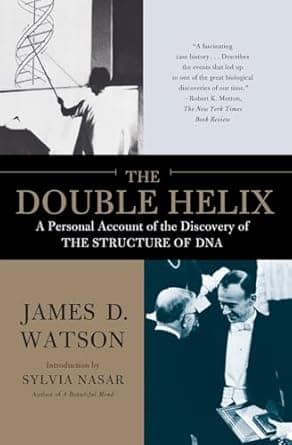
Book Stats
389
Upvotes
67
Downvotes
+322
Net Score
The Double Helix
by James D. Watson
Description
Watson's firsthand account of discovering the structure of DNA, offering a controversial but fascinating look at how scientific breakthroughs are made.
James Watson's memoir of the race to discover DNA's structure provides an inside look at one of the most important scientific discoveries of the twentieth century. Working with Francis Crick at Cambridge University, Watson describes the competitive, often chaotic process that led to their 1953 breakthrough.
Watson's candid account reveals the human side of scientific discovery—the ambition, competition, mistakes, and lucky breaks that contributed to their success. His portrayal of the key players, including Rosalind Franklin and Maurice Wilkins, has been controversial for its personal judgments and apparent sexism.
The book's description of the discovery process shows how scientific breakthroughs often depend on combining insights from multiple sources. Watson and Crick's success came from synthesizing X-ray crystallography data (much of it from Franklin's work), chemical knowledge about DNA's components, and model-building techniques.
Watson's narrative emphasizes the importance of intuition and pattern recognition in scientific work. The famous moment when they realized that DNA must be a double helix came not from systematic analysis but from creative insight about how the chemical components might fit together.
The book's treatment of competition in science is particularly revealing, showing how the race between different research groups pushed everyone to work faster and take risks. Watson acknowledges that their success depended partly on access to other researchers' data and insights, raising questions about collaboration and credit in scientific work.
The memoir's controversial aspects—particularly Watson's dismissive comments about Franklin and other women scientists—have sparked important discussions about gender and recognition in scientific fields. Despite these problems, the book provides valuable insights into how major discoveries are actually made.
The Double Helix won numerous awards and became a classic of science writing, demonstrating that scientists' personal accounts of their work can be as compelling as any fiction. It remains essential reading for anyone interested in the process of scientific discovery and the human personalities behind major breakthroughs.